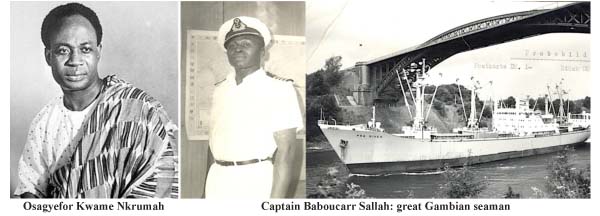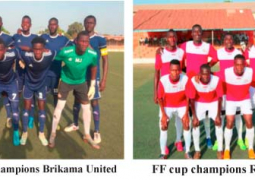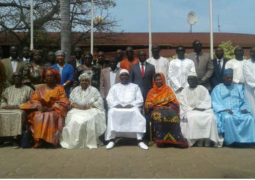
Another Gambian student in Accra at the time who wrote an op-ed in the Evening News was Omar Njie, who later became Gambian Foreign Minister in 1997. The optimistic comments of these Gambian Young Pioneers were noteworthy because at the time few people thought that The Gambia will survive as an independent state hence the sobriquet ‘improbable nation’ which was given to her by a visiting American journalist Berkely Rice.
Ghana was the only African country to send a high powered delegation to Bathurst (Banjul) to attend the Independence festivities in 1965. Nkrumah’s delegation to The Gambia for the independencecelebrations were Mumuni Bawuni, Minister of Local Government; Eric N Ocansey, Minister of Parks and Gardens; Aseidu Nii Forde, of the African Affairs Secretariat and Dr P. K Foli, Ghanaian Ambassador to Senegal, as reported in the Daily Graphic of 16 February 1965. TheParty Press in Accra were not only enthusiastic about The Gambia’s attainment of independence but were busy wooing her into the Nkrumahist Pan Africanist camp through positive editorials and opinion pieces such as the‘Gambia is Now Free Forever....’ in theDaily Graphic of 19 February 1965 or ‘Kwame Greets Gambia’ in the Daily Graphic of 18 February 1965.
Lamin Janha: Nkrumah’s factotum
A discussion of Nkrumah’s influence on the newly independent Gambia cannot be complete without a special mention of Lamin Janha’s relations with Nkrumah. He was born in Banjul in 1945. Ama Biney, in her magisterial The Political and Social Thought of Kwame Nkrumah, writes that he had been in Ghana from 1960 to the time of the 1966 coup, as part of a Gambian youth group that came to Ghana for youth training at the Young Pioneers Institute (YPI). He was ideologically committed to Nkrumah and made the decision to serve Nkrumah despite his own father’s deep objections. Janha informed Ama that the “Old Man” (as he referred to Nkrumah) treated him as a son. Biney asserts that Janha became so close to Nkrumah that he was privy to many people who approached Nkrumah with plans to restore him back to power following his overthrow. Also, for two years from 1968 according to Ama, Janha accompanied Nkrumah in his daily exercises at his Conakry Villa Syli residence, and played chess with the fallen Ghanaian leader. Indeed, the Osagyefo had found a trusted companion in the young Gambian. Janha only left Guinea in 1970, to help set up the Kwame Nkrumah Memorial Foundation in the Gambia.
According to Gambian historian Nana Grey-Johnson, the Foundation distributed Nkrumahist literature from its HQ at Picton Street in Banjul. Aside the Foundation, there were other Gambian youth groups such as the Black Brotherhood, Kent street vous, and Fansoto(Independence) which had strong Nkrumahist Pan-African agendas. These groups comprised former attendees of Nkrumah’s Pioneer Schools and although ephemeral, served to animate the Gambian capital with Pan-African ideas and slogans. They helped to factor in radical politics in the otherwise dreary, non-ideological twang that has become post independence Gambian politics.
Black Panthers in Bathurst
In 1969, these Nkrumahist youth groups managed to have the firebrand African revolutionary and Black Panther Stokley Carmichael and his wife Mariam Makeba to visit Gambia with a message of solidarity from Nkrumah in Conakry; in the same year, they forced President Senghor to cut short a visit to Gambia accusing him of being a ‘western stooge’. Significantly, they supported Jawara’s successful quest to make the country a Republic within the Commonwealth in 1970. During the military transition in 1994-1996, and in the Second Republic, former beneficiaries of the 1960s airlift of students to Ghana have continued to serve in government and influence national life.
Read Other Articles In Article (Archive)
Sunday: tough game for Zuwa FC in Bakau Nawetan
Sep 30, 2011, 2:38 PM



